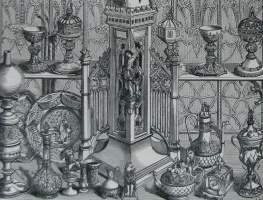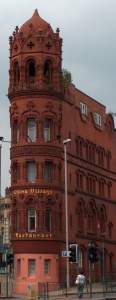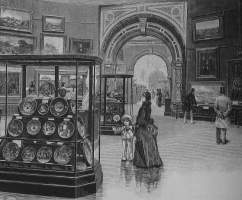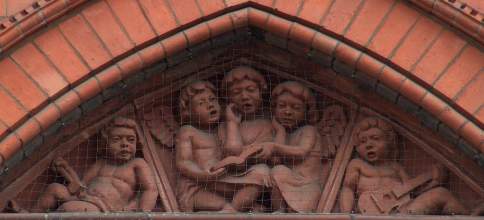 Wares from a Birmingham manufacture.
Wares from a Birmingham manufacture.
 Wares from a Birmingham manufacture.
Wares from a Birmingham manufacture.
Birmingham is England’s second city, and is of great significance to these pages, both in terms of the Victorian art to see there, and the many artists who lived or were trained there. This page tries to give a context for the several pages of this website devoted to Birmingham.
 A landmark building, Constitution Hill.
A landmark building, Constitution Hill.
It seems the town developed in some obscurity, being off the main routes across this part of Britain, which went rather through places such as Warwick. It grew steadily with ironmaking and the increased demand for the simpler necessities of life, and then the more costly items favoured by the well-to-do. Gunmaking, effectively confined to London until the 17th Century, took off in Birmingham when William III found capacity down south was not enough and he was faced with importing firearms. By 1815, Birmingham produced more guns than the whole of France. The coming of the steam engine increased the opportunities for manufacture, and the railways meant Birmingham goods could be provided across the country – the city was already the centre of the national canal system. Shoe buckles were manufactured to the number of 2 ˝ million pairs a year at their height, and by the Victorian era, Birmingham produced every sort of manufactured good, from trinkets (the disparagingly called ‘brummagen’, the term indicating ‘rubbish from Birmingham’), through buttons (600 million a year), pens and needles, through every sort of ironwork and metalworking of all kinds, from industrial ware through to wrought iron, to delicate jewellery work, silverware and other items of artistic pretension. The pictures above and below are illustrative of the low-end industrial activity of the city in the mid 1850s. Of particular interest to these pages, Birminham led the world in electroplating, through the famous Elkington works in Newhall Street.
Supporting the craft end of industry was a great number of craft workers, and we may mention in particular the Birmingham School of Art, and in particular their style of illustration, (Birmingham School style), which was to become perhaps the most recognisable of all illustrative work of the latter part of the 19th century. Arthur and Georgina Gaskin, CM Gere, EH New, Celia Levetus, and many others worked in this style.
There is no particularly characteristic school of painters associated with Birmingham (though the Birmingham Society of Artists was strong), but rather a variety of individually important artists originating from the city. Burne-Jones was born here, and later came back to inspire the Birmingham School illustrators mentioned above, and Fairfax Muckley, Bernard Sleigh, Maxwell Armfield and Sidney Meteyard all went to the School. Helen Allingham passed through the School before going on to become the first girl student at the Royal Academy Schools, and Kate Bunce both studied and later taught there. David Cox, the landscape painter was born in the city. And among sculptors, the primary interest of these pages, the City can count Albert Toft, T Nelson Maclean, WF Woodington and the Hollins family as either being born or growing up there.
 In the Museum and Art Gallery.
In the Museum and Art Gallery.
The Museum and Art Gallery holds one of the great Pre-Raphaelite collections, and much else Victorian. Architecturally, time has been unkind to Birmingham, with some of the most brutal of all road building and destruction of the 1960s destroying much that was good. In recent years, the city centre has begun to recover, with some excellent modern architecture, and attempts to conserve and rejuvenate the Victorian heritage rather than, as previously, just knock it down block by block. What then is left is not a coherent Victorian centre as in, taking the obvious comparison, Leeds, but a variety of rather disconnected streets and squares with Victorian interest. The sheer scale of the city means there is quite a lot to discover, and certainly I have not explored much of it. What remains of the Victorian heart is what we can describe as the civic area, with the Town Hall, Council Buildings and Museum and Art Gallery, in Chamberlain Square and the adjacent Victoria Square as the most impressive site, with fine architecture, decorated with sculpture and mosaic, and a small crop of statues.
Among the nearby streets, Corporation street, to the east, is the most important, with the remarkable Victoria Law Courts, which must be seen, and several other buildings of interest and a nice modern statue of Hebe (see bottom of this page). Waterloo Street, which becomes Colmore Row, running north and east from the Art Gallery and Town Hall, has a couple of heavily decorated buildings, and also passes by the Cathedral. Because of the self-effacing origins of the town, this is not some great medieval establishment, but rather a parish church – St Philips – which was promoted to cathedral church in late Victorian times. Somewhat more northerly is the Victorian and rather excellent Roman Catholic Cathedral by no less than Pugin – the first new Cathedral of the genre for some hundreds of years, but because of its youth, effectively bare of monuments. Along Birmingham's metro is Wednesbury, where St Bartholomew is a good example of a Black Country Parish church with monuments, including by the local sculptors William Hollins and Peter Hollins.
Back in central Birmingham, north of Colmore Row, Cornwall Street, Newhall Street et al contain a few excellent buildings, including one outstanding terra cotta one (again, see the Colmore Row page), and the bright red (though relatively unornamented in sculpture) buildings in the Jewellery Quarter, now somewhat touristified, represent a whole area rich in this material. And westerly, a grim little walk leads to Broad Street and the Hall of Memory, to see excellent sculpture by Albert Toft, who as alluded to above, was born in the area. Finally, among apparently several fine arcades, there survive just three with some remainder of their sculptured entrances or interiors.
 Hideous little Brummagen infants.
Hideous little Brummagen infants.
Birmingham pages:
The Metro connects Birmingham directly to Wolverhampton, via Wednesbury and Bilston, with significant sculpture to see:
Sculpture in England // Sculpture pages
Visits to this page from 13 Mar 2014: 8,801